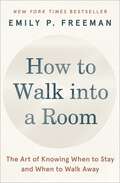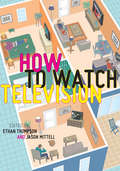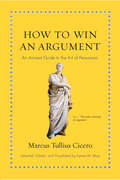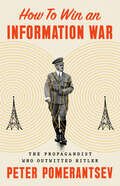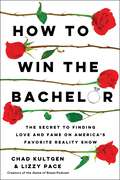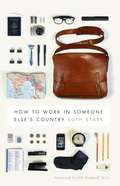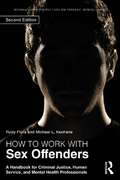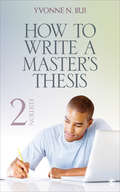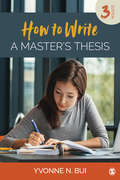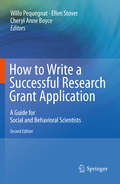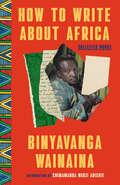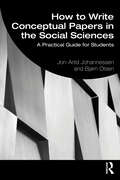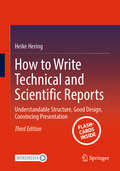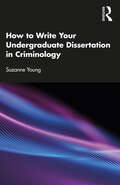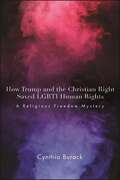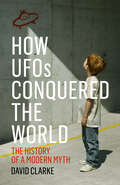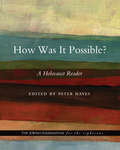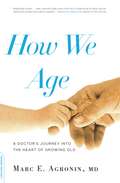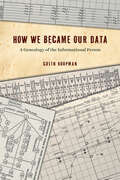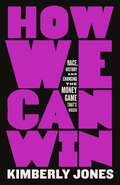- Table View
- List View
How to Walk into a Room: The Art of Knowing When to Stay and When to Walk Away
by Emily P. FreemanIf life were a house, then every room holds a story. What do we do when a room we’re in is no longer a room where we belong?What do you do when you start to feel a shift and must decide if it’s time to make a change? When it comes to navigating big decisions about when to stay and go, how can we know for sure when the time is right? Though we enter and exit many rooms over the course of our life—jobs, relationships, communities, life stages—knowing how and when it’s time to leave is a decision that rarely has a clear answer.Podcast host, spiritual director, and bestselling author of The Next Right Thing, Emily P. Freeman offers guidance to help us recognize when it’s time to move on from situations that no longer fit, allowing us to find new spaces where we can flourish and grow.How to Walk Into a Room helps us begin to uncover the silent, nuanced, and hidden arrows for anyone asking questions like: How do I know if it’s time to move on? What if I stay and nothing changes? What if I leave and everything falls apart?Through thought-provoking questions, spiritual practices, and personal stories, How to Walk into a Room will help you to know and name the caution flags in your current spaces, discern the difference between true peace and discomfort avoidance, navigate endings even when there is no closure, find peace for when you feel ready but it isn’t time, and courage for when it’s time but you don’t feel ready. For anyone standing in a threshold, here’s a book to help discern the how, when, and what now of walking out of rooms and into new ones with peace, confidence, and a whole heart.
How To Watch Television
by Ethan Thompson Jason MittellWe all have opinions about the television shows we watch, but television criticism is about much more than simply evaluating the merits of a particular show and deeming it 'good' or 'bad.' Rather, criticism uses the close examination of a television program to explore that program's cultural significance, creative strategies, and its place in a broader social context. How to Watch Television brings together forty original essays from today's leading scholars on television culture, writing about the programs they care (and think) the most about. Each essay focuses on a particular television show, demonstrating one way to read the program and, through it, our media culture. The essays model how to practice media criticism in accessible language, providing critical insights through analysis--suggesting a way of looking at TV that students and interested viewers might emulate. The contributors discuss a wide range of television programs past and present, covering many formats and genres, spanning fiction and non-fiction, broadcast and cable, providing a broad representation of the programs that are likely to be covered in a media studies course. While the book primarily focuses on American television, important programs with international origins and transnational circulation are also covered. Addressing television series from the medium's earliest days to contemporary online transformations of television, How to Watch Television is designed to engender classroom discussion among television critics of all backgrounds. Read: Introduction / Table of Contents / Sample Essays Online View: Clips from the Essays Visit the Facebook page.
How to Watch Television, Second Edition (User's Guides to Popular Culture #3)
by Ethan Thompson Jason MittellA new edition that brings the ways we watch and think about television up to the presentWe all have opinions about the television shows we watch, but television criticism is about much more than simply evaluating the merits of a particular show and deeming it “good” or “bad.” Rather, criticism uses the close examination of a television program to explore that program’s cultural significance, creative strategies, and its place in a broader social context.How to Watch Television, Second Edition brings together forty original essays—more than half of which are new to this edition—from today’s leading scholars on television culture, who write about the programs they care (and think) the most about. Each essay focuses on a single television show, demonstrating one way to read the program and, through it, our media culture. From fashioning blackness in Empire to representation in Orange is the New Black and from the role of the reboot in Gilmore Girls to the function of changing political atmospheres in Roseanne, these essays model how to practice media criticism in accessible language, providing critical insights through analysis—suggesting a way of looking at TV that students and interested viewers might emulate. The contributors discuss a wide range of television programs past and present, covering many formats and genres, spanning fiction and non-fiction, broadcast, streaming, and cable. Addressing shows from TV’s earliest days to contemporary online transformations of the medium, How to Watch Television, Second Edition is designed to engender classroom discussion among television critics of all backgrounds.To access additional essays from the first edition, visit the "links" tab at nyupress.org/9781479898817/how-to-watch-television-second-edition/.
How to Win an Argument: An Ancient Guide to the Art of Persuasion
by Marcus Tullius Cicero James M. MayAll of us are faced countless times with the challenge of persuading others, whether we're trying to win a trivial argument with a friend or convince our coworkers about an important decision. Instead of relying on untrained instinct--and often floundering or failing as a result--we'd win more arguments if we learned the timeless art of verbal persuasion, rhetoric. How to Win an Argument gathers the rhetorical wisdom of Cicero, ancient Rome's greatest orator, from across his works and combines it with passages from his legal and political speeches to show his powerful techniques in action. The result is an enlightening and entertaining practical introduction to the secrets of persuasive speaking and writing--including strategies that are just as effective in today's offices, schools, courts, and political debates as they were in the Roman forum.How to Win an Argument addresses proof based on rational argumentation, character, and emotion; the parts of a speech; the plain, middle, and grand styles; how to persuade no matter what audience or circumstances you face; and more. Cicero's words are presented in lively translations, with illuminating introductions; the book also features a brief biography of Cicero, a glossary, suggestions for further reading, and an appendix of the original Latin texts.Astonishingly relevant, this unique anthology of Cicero's rhetorical and oratorical wisdom will be enjoyed by anyone who ever needs to win arguments and influence people--in other words, all of us.
How to Win an Information War: The Propagandist Who Outwitted Hitler
by Peter PomerantsevFrom one of our leading experts on disinformation, this inventive biography of the rogue WWII propagandist Sefton Delmer confronts hard questions about the nature of information war: what if you can't fight lies with truth? Can a propaganda war ever be won? In the summer of 1941, Hitler ruled Europe from the Atlantic to the Black Sea. Britain was struggling to combat his powerful propaganda machine, crowing victory and smearing his enemies as liars and manipulators over his frequent radio speeches, blasted out on loudspeakers and into homes. British claims that Hitler was dangerous had little impact against this wave of disinformation. Except for the broadcasts of someone called Der Chef, a German who questioned Nazi doctrine. He had access to high-ranking German military secrets and spoke of internal rebellion. His listeners included German soldiers and citizens, as well as politicians in Washington DC who were debating getting into the war. And--most importantly--Der Chef was a fiction. He was a character created by the British propagandist Thomas Sefton Delmer, a unique weapon in the war. Then, as author Peter Pomerantsev seeks to tell Delmer's story, he is called into a wartime propaganda effort of his own: the US response to the invasion of Ukraine. In flashes forward to the present day, Pomerantsev weaves in what he's learning from Delmer as he seeks to fight against Vladimir Putin's tyranny and lies. This book is the story of Delmer and his modern investigator, as they each embark on their own quest to manipulate the passions of supporters and enemies, and to turn the tide of an information war, an extraordinary history that is informing the present before our eyes.
How to Win at The Challenge and Life: A Champion's Guide to Eliminating Obstacles, Winning Friends, and Making That Money
by Sydney BucksbaumYou&’ve seen the rivalries. You&’ve witnessed the blood, sweat, and tears. You&’ve celebrated the champions. But what does it really take to win MTV&’s The Challenge? And what happens after the cameras stop rolling? Since 1998, MTV&’s The Challenge has tested competitors&’ physical, mental, and emotional endurance. Some go on to become Challenge legends, going down in history as players who changed the game forever. But for each champion, there are dozens more who try and fail (over and over again) to earn the title. In her time covering the show, pop culture journalist and Challenge superfan Sydney Bucksbaum has gotten to know many of the champs, gaining an insider&’s knowledge of what goes into making a winning strategy—and how difficult it is to actually pull it off. Here, she profiles twenty-one of the most popular, successful, and infamous champions and reveals not only how they won The Challenge but also how they applied the skills they learned from the experience to their personal lives and careers. From seven-time winner Johnny &“Bananas&” Devenanzio, Challenge &“Godfather&” Mark Long, OG champ Veronica Portillo, elimination beast Emily Schromm to most-improved competitors Cara Maria Sorbello and Chris &“C.T.&” Tamburello, the best in the game look back at their decades of hard work, including the euphoric highs, devastating lows, and everything in between. Eye-opening and inspiring, How to Win at The Challenge and Life is the must-have book for any and all fans looking to level up their own lives—and learn never-before-heard stories from the people who have dominated the show in every way.
How to Win The Bachelor: The Secret to Finding Love and Fame on America's Favorite Reality Show
by Chad Kultgen Lizzy PacePerfect for fans of Bachelor Nation and Seinfeldia, an illuminating deep dive into the most successful reality TV franchise of all time—The Bachelor.Since its premiere in 2002, ABC&’s The Bachelor has become a staple of American television. Now, discover the fascinating history of the show, uncover the ins and outs of the phenomenon that has become Bachelor Nation, and take a deeper look at what separates the winners from the losers. From how best to exit the limo on Night One, to strategies for making a run for the all-important First Impression Rose, to how to avoid being labeled a villain, this clear-eyed guide illustrates the rules and strategies any would-be contestant should know. The ultimate must-read for every fan, How to Win the Bachelor gives you an inside look at the franchise where The Rose holds all the power.
How To Work In Someone Else's Country
by Ruth StarkWorking abroad offers adventure, friendship with people of other cultures, intimate familiarity with exciting places, and opportunities to make real differences in communities. It also presents countless challenges, ranging from packing and staying safe and healthy to balancing project objectives with on-the-ground realities, working with local officials, and forging respectful and productive relationships. These challenges and many more are tackled in "How to Work in Someone Else's Country. " Drawing on thirty years of experience as an international consultant in Africa, Asia, Latin America, and the Pacific, Ruth Stark provides guidance for anybody preparing to work in a foreign country. This easy-to-read guide is enlivened by real-life examples drawn from the author's journals and stories shared by colleagues. Slim enough to fit in a carry-on, this book is sure to come in handy wherever your work takes you.
How to Work with Sex Offenders: A Handbook for Criminal Justice, Human Service, and Mental Health Professionals (International Perspectives on Forensic Mental Health)
by Rudy Flora Michael L. KeohaneHow to Work with Sex Offenders is a cutting edge, state-of-the-art book that provides mental health professionals best practice techniques on how to clinically evaluate, interview, and treat this challenging patient population. Successful models of individual, family, and group models of psychotherapy are provided for the reader. In addition, this handbook walks the reader through the investigation, arrest, prosecution and court hearing process, from start to finish. Thoroughly revised, this new edition builds on additional research data and new information, adding advanced chapters on female offenders, Internet offenders, pornography, sexual addiction, rape and child and adolescent sexual misconduct. This is a must-read work for undergraduate and graduate students, law enforcement officers, prosecutors, judges, child protection service workers, therapists, and other professionals who work with sex offenders.
How to Write a Master's Thesis
by Yvonne N. BuiYvonne N. Bui's How to Write a Master's Thesis is a step-by-step guidebook that demystifies a process that can often prove to be overwhelming and confusing to graduate students. The tone and format of this applied book is reader-friendly and includes practical suggestions that go beyond informing what "should" be done. It is chock full of detailed explanations, examples, and supplemental materials that have been used successfully in advising students in completing their master's theses.
How to Write a Master′s Thesis
by Yvonne N. Bui"This is the best textbook about writing an M.A. thesis available in the market." –Hsin-I Liu, University of the Incarnate Word The Third Edition of How to Write a Master′s Thesis is a comprehensive manual on how to plan and write a five-chapter master’s thesis, and a great resource for graduate students looking for concrete, applied guidance on how to successfully complete their master′s degrees. While research methods and statistics courses may teach students the basic information on how to conduct research, putting it all together into a single project and document can be a challenge. Author Yvonne Bui demystifies this process by integrating the language learned in prerequisite methods and statistics courses into a step-by-step guide for developing a student′s own thesis or project.
How to Write a Master′s Thesis
by Yvonne N. Bui"This is the best textbook about writing an M.A. thesis available in the market." –Hsin-I Liu, University of the Incarnate Word The Third Edition of How to Write a Master′s Thesis is a comprehensive manual on how to plan and write a five-chapter master’s thesis, and a great resource for graduate students looking for concrete, applied guidance on how to successfully complete their master′s degrees. While research methods and statistics courses may teach students the basic information on how to conduct research, putting it all together into a single project and document can be a challenge. Author Yvonne Bui demystifies this process by integrating the language learned in prerequisite methods and statistics courses into a step-by-step guide for developing a student′s own thesis or project.
How to Write a Successful Research Grant Application
by Ellen Stover Cheryl Anne Boyce Willo PequegnatOver the last fifty years behavioral and medical research has been generously supported by the federal government, private foundations, and other philanthropic organizations contributing to the development of a vibrant public health system both in the United States and worldwide. However, these funds are dwindling and to stay competitive, investigators must understand the funding environment and know how to translate their hypotheses into research grant applications that reviewers evaluate as having scientific merit. The Second Edition of 'How to Write a Successful Research Grant Application' is the only book of its kind written by federal research investigators which provides technical assistance for researchers applying for biobehavioral and psychosocial research funding and can give them an edge in this competitive environment. The book provides invaluable tips on all aspects of the art of grantsmanship, including: how to determine research opportunities and priorities, how to develop the different elements of an application, how to negotiate the electronic submission and review processes, and how to disseminate the findings. Charts, visual aids, Web links, an extensive real-world example of a research proposal with budget, and a "So You Were Awarded Your Grant--Now What?" chapter show prospective applicants how to: - Formulate a testworthy--and interesting--hypothesis. - Select the appropriate research mechanism. - Avoid common pitfalls in proposal writing. - Develop an adequate control group. - Conduct a rigorous qualitative inquiry. - Develop a budget justification of costs. - Develop a human subjects of animal welfare plan. - Write a data analytic plan. - Design a quality control/assurance program. - Read between the lines of a summary of the review of your application. Although its focus is on Public Health Service funding, 'How to Write a Successful Research Grant' is equally useful for all research proposals, including graduate students preparing a thesis or dissertation proposal. Service providers in community-based organizations and public health agencies will also find this a useful resource in preparing a proposal to compete for grant funds from state and community resources, non-government organizations, and foundations.
How to Write About Africa: Collected Works
by Binyavanga WainainaFrom one of Africa&’s most influential and eloquent essayists, a posthumous collection that highlights his biting satire and subversive wisdom on topics from travel to cultural identity to sexuality&“A fierce literary talent . . . [Wainaina] shines a light on his continent without cliché.&”—The Guardian&“Africa is the only continent you can love—take advantage of this. . . . Africa is to be pitied, worshipped, or dominated. Whichever angle you take, be sure to leave the strong impression that without your intervention and your important book, Africa is doomed.&”Binyavanga Wainaina was a pioneering voice in African literature, an award-winning memoirist and essayist, and a gatherer of literary communities. Before his tragic death in 2019 at the age of forty-seven, he won the Caine Prize for African Writing and was named one of Time&’s 100 Most Influential People. His wildly popular essay &“How to Write About Africa,&” an incisive and unapologetic piece exposing the harmful and racist ways Western media depicts Africa with implicit bias and subjective clichés, changed the game for African writers and helped set the stage for a new generation of authors, from Chimamanda Ngozi Adichie to Yaa Gyasi. When Wainaina published a &“lost chapter&” of his 2011 memoir as an essay called &“I Am a Homosexual, Mum,&” which imagines coming out to his mother, he became a voice for the queer African community as well, adding a new layer to how African sexuality is perceived.How to Write About Africa collects these powerful pieces in a lively and imaginative set of essays about sexuality, art, history, and contemporary Africa. Wainaina&’s writing is playful, robust, generous, and full-bodied. He describes the modern world with sensual, emotional, and psychological detail, giving us a full-color view of a country and continent. These works present a portrait of a giant in African literature who left a tremendous legacy.
How to Write Conceptual Papers in the Social Sciences: A Practical Guide for Students
by Jon-Arild Johannessen Bjørn OlsenThis book is a practical guide on how to write conceptual papers and use conceptual generalization as a research methodology. Divided into two parts, the book first focuses on the scientific foundation for conceptual generalization, to identify what is a conceptual model and how conceptual models can be developed. Part two focuses on how to write a winning conceptual thesis, covering conceptual generalisation and empirical generalisation, and discusses research problems and questions, and how to analyse them. The authors cover different conceptual and analytical models to offer students a multitude of tools to visualize, interpret and uncover relationships and patterns. For example, they explore the thought experiment, analytical models, empirical causal models, analytical forms and data mining models, and outline a strategy for developing conceptual models to assist with students who wish to design their own conceptual paper. Students gain a clear understanding of the driving forces in the research process, how to define a research problem, how to analysis the problem and develop research strategies. Moving from concepts to hypotheses, the book also covers the main types of errors that may be encountered as students learn about understanding the development of models and how to develop a theory. Also including a checklist for students, and a list of definitions and concepts, this is the ideal resource for advanced undergraduate and postgraduate students, and researchers, in the social sciences.
How to Write Technical and Scientific Reports: Understandable Structure, Good Design, Convincing Presentation
by Heike HeringHow to Write Technical and Scientific Reports This textbook introduces all important and necessary knowledge to create written reports or oral presentations about STEM and engineering topics in a professional and efficient manner. By showing example structures and right/wrong comparisons you will get many practical hints on how to design your own report. The examples are mostly derived from works written by the authors and therefore they often deal with mechanical engineering topics. There are different sections about frequent mistakes in Technical and Scientific Reports, the use of word processors and tools for creating presentations, the design of figures and tables as well as the oral presentation of the Technical or Scientific Report, also as a short statement. In this 3rd edition all texts were revised and updated, the sections with references were updated, the glossary and index were expanded and Springer Nature (SN) Flashcards were added to help you to remember the introduced knowledge and to create Technical and Scientific Reports even more efficiently. Test your knowledge with questions and answers about the book with Springer Nature Flashcards.
How to Write Your Undergraduate Dissertation in Criminology
by Suzanne YoungThis book provides a guide for undergraduate criminology and criminal justice students undertaking their final-year dissertation. It speaks to the specific challenges for criminology students who may wish to research closed institutions (such as prisons, courts, or the police) or vulnerable populations (such as people with convictions, victims of crime, or young people), and offers guidance on how to undertake research on these topics whilet avoiding many of the access and ethical obstacles. It takes students through each phase of the dissertation, from designing and planning the research to writing up and presenting the completed work. The complexities of undertaking research on sensitive topics and with criminal justice institutions are discussed throughout, offering an insight into some of the challenges that students may be faced with and suggestions to overcome obstacles. It offers practical guidance for empirical and library-based projects and provides students with suggested resources for accessing primary and secondary data. It utilises a mixture of worked examples, top tips, practical strategies, and student activities to ensure the dissertation is a manageable and enjoyable process. This book will be beneficial to all undergraduate criminology students who have to undertake either a library-based or empirical dissertation. The examples and activities in the book will also be useful for dissertation supervisors who can use them to support their dissertation students.
How Toddlers Learn the Secret Language of Movies
by Cary BazalgetteThis book takes a radically new approach to the well-worn topic of children's relationship with the media, avoiding the "risks and benefits" paradigm while examining very young children's interactions with film and television. Bazalgette proposes a refocus on the learning processes that children must go through in order to understand what they are watching on televisions, phones, or iPads. To demonstrate this, she offers unique insight from research done with her twin grandchildren starting from just before they were two years old, with analysis drawn from the field of embodied cognition to help identify minute behaviours and expressions as signals of emotions and thought processes. The book makes the case that all inquiry into early childhood movie-viewing should be based on the premise that learning–usually self-driven–is taking place throughout.
How Trump and the Christian Right Saved LGBTI Human Rights: A Religious Freedom Mystery (SUNY series in Queer Politics and Cultures)
by Cynthia BurackDuring the Obama administration, Christian conservatives insisted that securing human rights for LGBTI people abroad diminished human rights protections for people of faith. During the 2016 presidential election, the Christian right backed Donald Trump and demanded an end to sexual orientation and gender identity (SOGI) foreign policy. Did the Trump administration move to terminate US advocacy for SOGI human rights? Did Christian conservative US officials and elites do everything in their power to publicize, curb, defund, and undermine US support for SOGI? If not—spoiler alert: they did not—why not? Analyzing SOGI human rights and religious freedom foreign policy, How Trump and the Christian Right Saved LGBTI Human Rights reveals the indifference, mendacity, and political interests at play in Trump's alliance with Christian right elites.
How UFOs Conquered the World: The History of a Modern Myth
by David Clarke“Cover[s] all the major themes of ufology, ranging from lights in the sky to crashed saucers, government cover-ups and alien abductions . . . fascinating.” —Popular Science BooksNeither a credulous work of conspiracy theory nor a skeptical debunking of belief in “flying saucers,” How UFOs Conquered the World explores the origins of UFOs in the build-up to the First World War and how reports of them have changed in tandem with world events, science and culture. The book will also explore the overlaps between UFO belief and religion and superstition.“An insightful, informative and thought-provoking book on UFOs and the UFO culture . . . In the following ten chapters, he writes about his pursuit of the ‘truth’ about UFOs. It is a fascinating journey.” —Skeptic
How Was It Possible?: A Holocaust Reader
by Peter HayesAs the Holocaust passes out of living memory, future generations will no longer come face-to-face with Holocaust survivors. But the lessons of that terrible period in history are too important to let slip past. How Was It Possible?, edited and introduced by Peter Hayes, provides teachers and students with a comprehensive resource about the Nazi persecution of Jews. Deliberately resisting the reflexive urge to dismiss the topic as too horrible to be understood intellectually or emotionally, the anthology sets out to provide answers to questions that may otherwise defy comprehension. This anthology is organized around key issues of the Holocaust, from the historical context for antisemitism to the impediments to escaping Nazi Germany, and from the logistics of the death camps and the carrying out of genocide to the subsequent struggles of the displaced survivors in the aftermath. Prepared in cooperation with the Jewish Foundation for the Righteous, this anthology includes contributions from such luminaries as Jean Ancel, Saul Friedlander, Tony Judt, Alan Kraut, Primo Levi, Robert Proctor, Richard Rhodes, Timothy Snyder, and Susan Zuccotti. Taken together, the selections make the ineffable fathomable and demystify the barbarism underlying the tragedy, inviting readers to learn precisely how the Holocaust was, in fact, possible.
How We Age: A Doctor's Journey into the Heart of Growing Old
by Marc AgroninA young doctorOCOs reflections on his experiences as a nursing-home psychiatrist?with remarkable stories of vitality and growth that transformed his view of aging
How We Became Our Data: A Genealogy of the Informational Person
by Colin KoopmanWe are now acutely aware, as if all of the sudden, that data matters enormously to how we live. How did information come to be so integral to what we can do? How did we become people who effortlessly present our lives in social media profiles and who are meticulously recorded in state surveillance dossiers and online marketing databases? What is the story behind data coming to matter so much to who we are? In How We Became Our Data, Colin Koopman excavates early moments of our rapidly accelerating data-tracking technologies and their consequences for how we think of and express our selfhood today. Koopman explores the emergence of mass-scale record keeping systems like birth certificates and social security numbers, as well as new data techniques for categorizing personality traits, measuring intelligence, and even racializing subjects. This all culminates in what Koopman calls the “informational person” and the “informational power” we are now subject to. The recent explosion of digital technologies that are turning us into a series of algorithmic data points is shown to have a deeper and more turbulent past than we commonly think. Blending philosophy, history, political theory, and media theory in conversation with thinkers like Michel Foucault, Jürgen Habermas, and Friedrich Kittler, Koopman presents an illuminating perspective on how we have come to think of our personhood—and how we can resist its erosion.
How We Became Sensorimotor: Movement, Measurement, Sensation
by Mark PatersonAn engrossing history of the century that transformed our knowledge of the body&’s inner senses The years between 1833 and 1945 fundamentally transformed science&’s understanding of the body&’s inner senses, revolutionizing fields like philosophy, the social sciences, and cognitive science. In How We Became Sensorimotor, Mark Paterson provides a systematic account of this transformative period, while also demonstrating its substantial implications for current explorations into phenomenology, embodied consciousness, the extended mind, and theories of the sensorimotor, the body, and embodiment.Each chapter of How We Became Sensorimotor takes a particular sense and historicizes its formation by means of recent scientific studies, case studies, or coverage in the media. Ranging among a diverse array of sensations, including balance, fatigue, pain, the &“muscle sense,&” and what Maurice Merleau-Ponty termed &“motricity,&” Paterson&’s analysis moves outward from the familiar confines of the laboratory to those of the industrial world and even to wild animals and their habitats. He uncovers important stories, such as how forgotten pain-measurement schemes transformed criminology, or how Penfield&’s outmoded concepts of the sensory and motor homunculi of the brain still mar psychology textbooks.Complete with original archival research featuring illustrations and correspondence, How We Became Sensorimotor shows how the shifting and sometimes contested historical background to our understandings of the senses are being extended even today.
How We Can Win: Race, History and Changing the Money Game That's Rigged
by Kimberly JonesAn Amazon Editors' Pick: HistoryA breakdown of the economic and social injustices facing Black people and other marginalized citizens inspired by political activist Kimberly Jones' viral video, “How Can We Win.”“So if I played four hundred rounds of Monopoly with you and I had to play and give you every dime that I made, and then for fifty years, every time that I played, if you didn't like what I did, you got to burn it like they did in Tulsa and like they did in Rosewood, how can you win? How can you win?"When Kimberly Jones declared these words amid the protests spurred by the murder of George Floyd, she gave a history lesson that in just over six minutes captured the economic struggles of Black people in America. Within days the video had been viewed by millions of people around the world, riveted by Jones’s damning—and stunningly succinct—analysis of the enduring disparities Black Americans face.In How We Can Win, Jones delves into the impacts of systemic racism and reveals how her formative years in Chicago gave birth to a lifelong devotion to justice. Here, in a vital expansion of her declaration, she calls for Reconstruction 2.0, a multilayered plan to reclaim economic and social restitutions—those restitutions promised with emancipation but blocked, again and again, for more than 150 years. And, most of all, Jones delivers strategies for how we can effect change as citizens and allies while nurturing ourselves—the most valuable asset we have—in the fight against a system that is still rigged.
